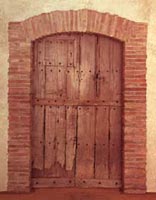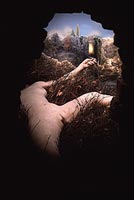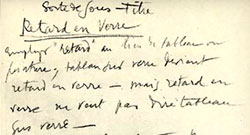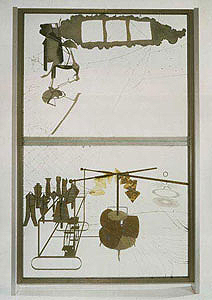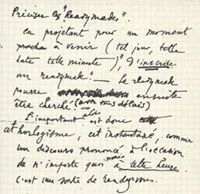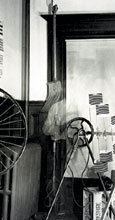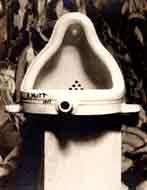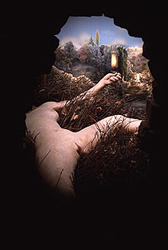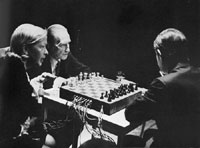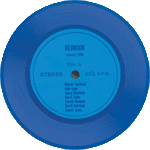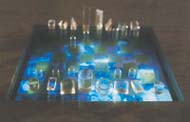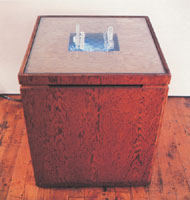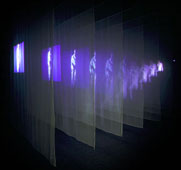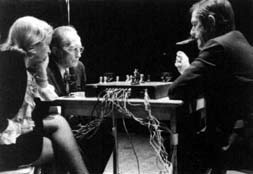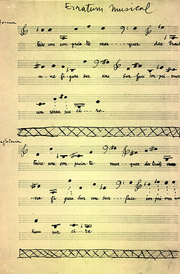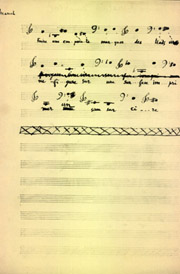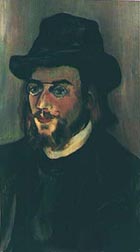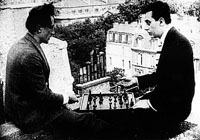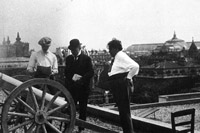(The following example of Marcel Duchamp’s encounter with the mind of Leonardo da Vinci is excerpted from a longer essay. Duchamp discovered Leonardo’s anatomical writings and drawings, through photogravure reproductions, in the Bibliotheque Sainte Genevieve in Paris, first as a curious visitor in 1910, then as a professional librarian with a great deal of spare time, in 1913-14. Outside the library, the publication of a new French translation of Leonardo’s Treatise on Painting in 1910 aroused great interest among all three Duchamp brothers and their Cubist friends at Puteaux.)
In his Treatise on Painting Leonardo da Vinci advised:
| “When you wish to remember well something you have studied, do this: when you have drawn the same object so many times that you have it in your memory, try to execute it without the model. Now trace the model on a thin smooth glass, and place it upon the drawing you have made without the model, and note well where the tracing does not coincide with your drawing. Where you find that you have made errors, resolve not to repeat your mistakes. Return to the model and draw the wrong part again so many times that you will have committed its image to the mind.” |
Leonardo urged young painters to study nature, observe acutely, and remember everything, in order to develop the ability to produce complex compositions with many figures in motion on a broad expanse of landscape. Marcel Duchamp, in a note in the Green Box, (Fig. 1) contradicted this passage from the Treatise on Painting. He seemed to acknowledge its significance by undoing it. He ran Leonardo’s advice in reverse;
“To lose the possibility of recognizing 2 similar objects– 2 colors, 2 laces, 2 hats, 2 forms whatsoever. To arrive at the Impossibility of sufficient visual memory to transfer from one like object to another the memory imprint.
–Same possibility with sounds; with brain facts” |
click to enlarge

Figure 1
Marcel Duchamp, Note from
the Green Box, 1934
Duchamp evoked a psychic state in which, from one instant to the next, the mind would sustain no overlapping visual imprint (or tracing on glass, as Leonardo might say). He called for a total collapse of short–term memory. This would be a terrifying experience. But looked at in another way, it would be intensely interesting. Everything would be new all the time. An artist who could attain this frame of mind, even to a minute degree, would produce some unforeseen works. Such an artist, Duchamp hoped, might even become liberated from the bounds of practice and tradition, and “make works which are not works of ‘art’.”
A painter could make a sculpture. That would be nothing new. But in an extreme state of self–induced forgetfulness, a painter might lose track of which of the five senses governs his art form. He might slip away from the use of the retina, the organ of sight, and start hearing, for example, rather than seeing. He could become a composer of music without even noticing it.
click to enlarge

Marcel Duchamp, Note #183,
in Paul Matisse
(ed. & trans.),
Marcel Duchamp,
Notes, 1983
A previously unknown collection of notes by Duchamp was published in 1980, a dozen years after his death. The sheet which came to be designated as #183 reads: (Fig. 2)
“…like…luminous electric lights which light up successively, a line of identical sounds could turn around the listener in arabesques (on the right/ left/ over/ under)…
Develop: one could, after training the listener’s ear, succeed in drawing a resembling and recognizable profile. With more training make large sculptures in which the listener would be a center. For example, an immense Venus de Milo made of sounds around the listener. This probably presupposes an aural training from childhood and for several generations.”
A proposal for another musical occurrence, a construction made of a single sound drawn out over time, sprang out of the mind of Marcel Duchamp during his study of Leonardo’sWindsor Anatomy, Folio B. It is as if Duchamp, in the course of pondering the most succinct and beautiful anatomical drawings ever made, was overcome by a wave of the esthetic amnesia he had only dared to imagine. Had he succeeded in making one of those “works which are not works of ‘art'”?
click to enlarge

Figure 4
French translation
of da Vinci’s manuscript
click to enlarge

Figure 3
Leonardo da Vinci,
Transcription of
the manuscript page
Duchamp jotted down instructions for “The Tuner,” a performance for a solo piano tuner on an empty stage. It was based on another jotting– the number 3, written backwards eight times, by Leonardo da Vinci. The numerals run like leaking water down the right–hand margin of Leonardo’s manuscript page, disconnected from the block of text. (Fig. 3) A transcription of the original Italian, and a translation into French, follow the photogravure facsimile of Leonardo’s original, and here the eight 3’s are lined up in a neat horizontal row that stands out as a peculiar typographical feature, an unexpected visual rhythm. (Fig. 4) Any reader, with no knowledge of Italian or French, can decipher this line: “3 3 3 3 3 3 3 3.”
Duchamp and Leonardo shared an infatuation with the number “3.” A triad was used by both artists to hold back the tide of infinity, or infinite complexity, at a very early point in the enumerating or measuring process. “Three is infinity,” Duchamp said. “One is unity, two is double, duality, and three is the rest.” There was no need to go any further. “When you’ve come to the word three, you have three million–it’s the same as three.”
click to enlarge

Figure 5
Marcel Duchamp,
The Bride Stripped Bare
by Her Bachelors,
Even [a k.a. The
Large Glass], 1915-23
The list of components of the Large Glass executed in triplicate covers the work from top to bottom: 3 draft pistons, 3 isolating plates, 3 standard stoppages,3 rollers on the chocolate grinder, 3 oculist witnesses, 3 X 3 cannon shots, 3 X 3 malic molds, 3 X 3 capillary tubes. A catalog of the unexecuted tripled parts, called for in the Green Box and the posthumous notes but ever appearing in the Large Glass, includes the following: 3 splash/rashes, 3 falls, 3 feet for the Juggler of Gravity, 3 summits for the combat arbles, 3 desire centers,”3 “positive rods of the desire dynamo,”and the “hot chamber of the triple decision.”
So Duchamp used the number three to tie together, as with bits of wire, the members of his ungainly automaton called The Bride Stripped Bare by Her Bachelors, Even.(Fig. 5)
Leonardo used tripling for the reverse project, the project of aking apart a once–living human body. He needed an ordering mechanism for material that might otherwise slip out of his control. As he removed the outerlayers of the body and probed into the tissues of a human corpse he repeatedly,at each step of the way, for each limb and each organ, called for three separatedissections: one carried out from the top, one from the side,and one from the ottom. Each dissection, in turn, would require, if he could get it, a fresh pecimen.
Anatomists in Leonardo’s time had no preservatives, and corpses egan to decompose even as the investigators worked. If a forearm, for example, ere placed on the table with its palm facing downward, tissue could be removed with a scalpel and, very gingerly, with fingers, to reveal the blood vessels. The next step, in theory, would be to turn the arm over. The anatomist could then trace, on the underside of the arm and hand, the sources and destinations of the vessels already laid bare. But this was impossible because of disintegration. The specimen would already be undermined by rot, and “on account,” said Leonardo,
“of the very great confusion which results from the mix–up of membranes with veins, arteries, nerves, tendons, muscles, bones, and especially blood, which itself dyes every part the same color….Therefore it is necessary to perform more dissections. You need three to acquire full knowledge of the veins and arteries, destroying with the utmost diligence all the rest, and another three to obtain knowledge of the membranes, and three for the tendons, muscles, and ligaments, three
for the bones and cartilages and three for the anatomy of the bones.”
Clearly this was goullish work, and Leonardo issued a warning to prospective artist–anatomists; “Though you may have a love for such things you will perhaps be deterred by a weak stomach, or, if this does not restrain you, then
perhaps by the fear of living through the night hours in the company of these corpses, quartered and flayed and horrible to behold.”
Leonardo needed the number three to organize and objectify, and perhaps to keep some of the horror at bay. Proposals for a great series of dissections, to be accompanied by drawings and diagrams, appear as unrealized fragments in several of his manuscripts. In the Windsor Anatomy, Folio Bhe writes:
“We shall make three diagrams…with the bones sawn asunder so as to show their thickness and hollowness. Three other diagrams we shall
make for the bones entire, and for the nerves which spring from the nape of the neck and showing into what limbs they ramify. And three others for the bones and veins and where they ramify, then three for the muscles and three for the skin and the measurements,and three for the woman to show the womb and the menstrual veins
which go to the breasts.” |
At this moment, while writing this passage, Leonardo was seized by a fit of graphic exuberance. At least this is what the evidence on the manuscript page appears to record. His hand would not stop drawing a mark that looks like the letter E, eight times, down the side of the page. This marginal calligraphy reveals a childlike excitement. It also demonstrates a simple truth about human anatomy. The musculature of the right hand is structured so that, when manipulating a writing implement or tool, a clockwise circular motion feels natural and pleasurable. (This fact has come to determine the design of cork–screws, can–openers, and the configurations of our written alphabet.) Leonardo was a born draftsman, perhaps the greatest to ever live, and a born lefty. At an early age he developed full command of his most important tool, the drawing hand. But the left hand wants to follow a counter–clockwise path, and he refused to impede its natural movement in any way. It is for this reason that Leonardo taught himself to produce ‘mirror–writing,’ running across the page backwards, from right to left. But now his hand would not stop spinning like a tiny funnel cloud, delineating the numeral 3 in reverse. It escaped from his text and spilled in a free–fall down the side of the page.
click to enlarge

Figure 6
Marcel Duchamp,
Bride, 1912
Marcel Duchamp arrived on this scene, on the back of Sheet #20 in the Windsor Anatomy, Folio B, over four–hundred years later, in 1910. For the next two years he struggled as a painter, secretly, with Leonardo’s anatomical images. He was in awe of their mechanical complexity, and their chilling sense of precision. Yet they were terribly alive, sometimes almost eliciting an olfactory experience of life and death. At the end of this struggle, during the summer of 1912, Duchamp produced the painting the Bride. (Fig. 6) He was approaching artistic maturity by following the solitary path he had set for himself, a path that would call for spells of lengthy contemplation intertwined with impulsive, illogical actions.
click to enlarge

Figure 7
Marcel Duchamp,Note
#183,in Paul Matisse
(ed. & trans.),
Marcel Duchamp, Notes, 1983
Duchamp was deliberately constructing within himself a pathway to delirium, a controlled and self-imposed delirium. He wanted to have this state of mind available as an artist’s tool, to provide the possibility of bringing together
two ideas that had never been joined before, or to jumble up the senses, switching, for example, seeing and hearing. At some moment during these two years Duchamp must have, following his own prescription, lost “the possibility of recognizing 2 similar objects…2 forms whatsoever…” His mind stumbled upon the aberrant trail of reversed 3’s in Leonardo’s anatomical manuscript. In an instant, it seems, his mind was cleared of his growing preoccupation with the number 3. He had ‘lost the possibility’ of recognizing the number, but saw it instead as an E, not the written letter, but the musical note. His hand took off like Leonardo’s and started to spin out backward 3’s, or E’s. The initial effort was botched (Fig. 7); Duchamp was right-handed, so the counter-clockwise motion of his pen went awry. But in his next attempt he produced eight exuberant E’s in an upwardly tilted procession,followed, for good measure, by another row of four. Duchamp had emerged with a piece of music, a miniature “happening,” composed solely of the note E from the musical octave. He took a “readymade” activity, the maintenance of a musical instrument, and transformed it into the performance itself. He was fifty years ahead of his time:
“THE TUNER–
Have a piano tuned on stage–
EEEEEEEE
EEEE
or
make a movie of the tuner tuning, and synchronize the tunings on a piano.
Or rather, synchronize the tuning of a hidden piano.
or
have a piano tuned on the stage in the dark.
Do it technically and avoid
all musicianship–“
Duchamp left this note unpublished, among the group to be discovered after his death.It shows that readymade music was a step on the path to readymade objects,and that this path led him through Leonardo da Vinci’s notebooks, past the number 3.
NOTES
1. A. Phillip McMahon, trans., Treatise on Painting by Leonardo da Vinci (Princeton: Princeton Univ. Press, 1956) 47; Josephin Peladan, trans. and ed., Leonard de Vinci, Traite de la Peinture (Paris: Librairie Delagrave, 1910) 101.
2. Michel Sanouillet and Elmer Peterson, eds., The Writings of Marcel Duchamp
(New York: Da Capo Press, 1973) 31.
3. Paul Matisse, ed. and trans., Marcel Duchamp, Notes (Boston: G. K. Hall, 1983) note #183.
4. Pierre Cabanne, Dialogues with Marcel Duchamp (New York: Viking Press, 1971) 47.
5. Cabanne, Dialogues 47.
6. Matisse, Notes, notes #63 and #251.
7. Ibid., note #162 recto.
8. Ibid., note #131.
9. Edward MacCurdy, ed., The Notebooks of Leonardo da Vinci (New York: George Braziller, 1954) 160;and Serge Bramly, Leonardo (New York: Penguin Books, 1991) 374.
10. MacCurdy, Notebooks 166.
11.Ibid. 131-132.
12. Matisse,Notes, note #199.
Figs. 1, 2, 5-7
©2002 Succession Marcel Duchamp, ARS, N.Y./ADAGP, Paris. All rights reserved.
